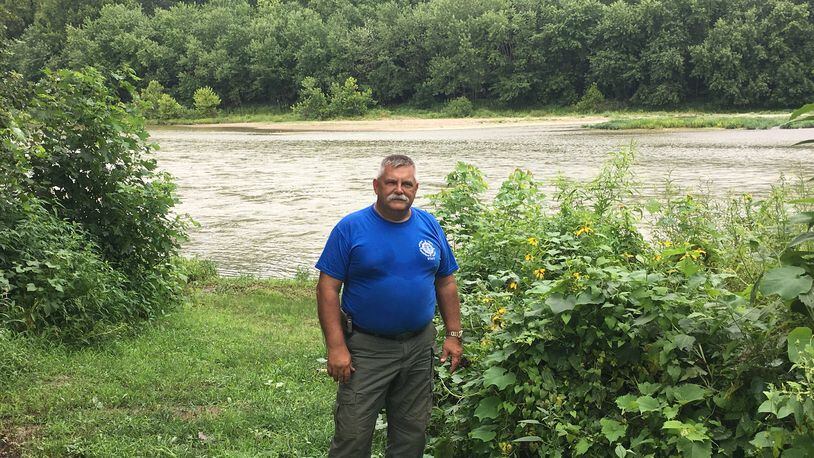“Please remember that a cyclist cannot take a large glass vase home with them,” she said with a laugh. “They’ll need some type of shipping service.”
Connor, speaking at a Franklin Area Chamber of Commerce luncheon this month, encouraged people to think of the Great Miami Riverway not as a new name for the bike path along the river, or the river itself, but as a new tourism area that includes everything within about a mile from either shore of the Great Miami River, along a 99-mile stretch from Sidney to Hamilton.
“Embrace the trail community,” she said. “If you can provide free water, you can provide a bike rack, anything like that is very important.”
Ultimately, proponents hope the riverway region’s marketing can be like that of the Outer Banks in North Carolina, or the Smokey Mountains in Tennessee and North Carolina; and Napa Valley, in California.
The riverway area already is being marketed in Cincinnati and Columbus, and next year commercials for it will air across Ohio, as well as surrounding states, including the Indianapolis market.
Filling Trail Gaps
Meanwhile, the bicycling trail that will be a focus of the marketing is making steady progress toward being 99 miles long, as well.
“The bike path between Middletown and Franklin will actually be completed in 2020, so you won’t be the stopping point anymore” from points north on the trail, Connor told her Franklin audience.
Completion of the 1.4-mile gap between Middletown and Franklin has been funded. Once it is finished, people will be able to hike or bike all the way from Middletown to Piqua.
Meanwhile, there’s a 7.4-mile break in the path between Middletown and Hamilton. Of that, 2.3 miles are being developed by the city of Monroe. For the rest, “MetroParks of Butler County is working with partners on the rest of the gap to figure out construction and funding estimates,” she told this media outlet.
Even before those gaps are spanned, “keep in mind that the Great Miami River Recreation Trail intersects with other trails to form the Nation’s Largest Paved Trail Network, so there are tons of options east and west as well,” she added.
From Hamilton Downriver
Meanwhile, in Hamilton, the same married couple that has been developing the Riverside Natural Area toward the southern edge of the city along the river’s eastern shore also has been working to create a canoe/kayak launch there, around the Great Miami River’s 33-mile marker, close to Hamilton’s wastewater treatment plant.
The launch area already exists — although it isn’t marked or designated anywhere — but Troy and Kathy Schwable, who have essentially created the Riverside Natural Area, hope to level out the land leading to the shoreline gap. Ultimately, they’d like to make it possible for people not to have to carry their canoes or kayaks a fairly good distance from the treatment plant’s parking lot.
“We’ll probably put a sign out that lets people know” where the launch is, Troy Schwable said. “This is the 33-mile marker, right here. From this point, all the way down to the Ohio River, there are no more dams. So this is the longest stretch that you can paddle without having to ford any more man-made structures.”
To use the launch, people need to have a means of transportation from wherever it is downriver that they stop paddling.
He’s also planning to create in the Riverside Natural Area a Linden Picnic Grove, complete with several Linden trees, for which the Lindenwald (Linden Forest) neighborhood is named, perhaps with a water fountain.
Economic Activity
During the first six months of 2018, more than $274 million was invested along the riverway, Connor announced early this month. That includes projects like The Marcum in Hamilton, an under-construction complex of more than 100 apartments, plus restaurants and shops.
Those figures don’t include all the communities, including areas of Warren County, or investments in parks, Connor said.
She said she was unable to reveal all the costs, which were provided by local governments, because some of them are confidential. But asked to do so by this media outlet, she provided county figures, which are listed from upriver down:
- Shelby County (home to Sidney): $1 million;
- Miami County (which includes Piqua and Troy): $86 million;
- Montgomery County (including riverway communities Dayton, West Carrollton and Miamisburg): $170 million;
- Warren County (including Franklin): Not available; and
- Butler County (with members Middletown and Hamilton): $17 million.
Other developments and news
Here’s some other news involving the riverway:
- The riverway project soon will be installing 9-foot-tall kiosks, 11 of them this year.
- For existing signs along the bike paths that run along the river, "We've added that teal panel on the bottom just for branding. It does not change who manages the trail," Connor said.
- In 2017, $1.8 million was spent on river-access improvements, including things like removing low-level dams and installing bike ramps.
- Dayton recently lifted its ban on using inner-tubes on the Great Miami River, Connor said.
About the Author
